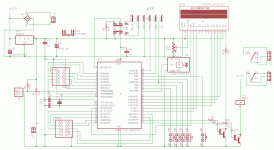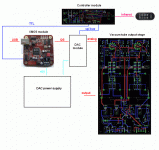Indeed I would ideally use that solution also, havent thought up a suitably low noise way to drop the voltage within the tolerance level of the onboard regs yet. I did discuss some options with Lucian by email some time back and have ended up going for a LT1085 regulator (not yet finished building that though).
battery as voltage reference with divider and some sort of power transistor follower, even a couple of those spare lme49600 in parallel would work. that or just a good tempco power resistor divider by itself. you are still using the onboard regs yes or is this a direct power input pin?
What is terrible about it?
it just sounds worse compared to vista or w7 (with similar or even less optimization)
XP is IMO the worst OS released my Microsoft, after 9x family. If you dont want newer OS, try 2003 server.
What a pity.
Applying one or two LiPoFe4 would have been IMO the ideal choice for a great external PS.
Add a few leds to drop the 6.6V... but they introduce a little noise, so it will be a less perfect PSU.
Indeed I would ideally use that solution also, havent thought up a suitably low noise way to drop the voltage within the tolerance level of the onboard regs yet. I did discuss some options with Lucian by email some time back and have ended up going for a LT1085 regulator (not yet finished building that though).
This is maybe a better idea.
Last edited:
I don't think multi stage regulation is a good thing.
Multistage? battery +1 regulator, is one stage, with leds is not even a regulation just dropout.
Multistage? battery +1 regulator, is one stage, with leds is not even a regulation just dropout.
Usually there are more onboard regs ( 5->3,3) or even DC/DC converters on the board.
That might not be the case with the WaveIo. It is the case with the Audio-GD device.
it just sounds worse compared to vista or w7 (with similar or even less optimization)
XP is IMO the worst OS released my Microsoft, after 9x family. If you dont want newer OS, try 2003 server.
It is amazing that you find a difference between two versions of the same codebase with the same kernel. WaveIO, in addition to being a digital bridge, provides correction for the shortcomings of any non-rt OS much as corrective lenses improve less than perfect vision. Audio class 2 + thesycon + XMOS + Lucien's design & implementation utilize buffers to assure timely delivery of a bit-perfect PCM stream directly to the DAC. Improving on XP (or any other non-rt OS) when used with WaveIO would require elimination of the few picoseconds of jitter or use of the DAC clock directly, neither of which could be accomplished by any user space application.
The scheduler for server 2003 switches the context less often than XP so is less responsive to user input. Deferred procedure calls are ALL executed before the scheduler or any user space context switches can occur. On the same hardware, the DPC latencies would be identical when running XP or server 2003.
WaveIO is like a corrective lens for poor digital timing. Unlike analog audio, digital audio can be made perfect and that perfection can be tested. As long as there is no buffer under-run, the only cause of that being excessive DPC latency, whether the bits are pushed across USB by windows, linux, or mac is completely irrelevant.
It is amazing that you find a difference between two versions of the same codebase with the same kernel. WaveIO (...)
Haven't tried with the waveIO, actually I dont have one in my hands yet. In the past i preferred 2003 server to XP. 2003 kernel was the base for Vista (thanks god I'd say).
Today I'm pretty much satisfied with w7 sp1 and I use it also on the dedicated computer. Latency is definitely not the only parameter to verify that the OS is optimized.
We are getting ot
Usually there are more onboard regs ( 5->3,3) or even DC/DC converters on the board.
That might not be the case with the WaveIo. It is the case with the Audio-GD device.
This is a good consideration. Impedance of such regs has to be verified. Since I plan to regulate very well the oscillators psu, i'll talk with Lucian about how it is implemented in the waveIO before drawing out the final specs of my psu.
The main voltage is not that critical instead, esp. if you isolate or power the USB separately and linearly like i'll do.
Today I received my WaveIO card, and I have to say that I'm impressed by both the build quality and the communication with Lucian, absolutely professional. Installing the drivers on a Windoze computer was a breeze, card is recognized. But....this was just for trying, because my music computer is a small laptop with Linux mint as OS. Here the card is not recognized with lsusb, also cat /proc/asound/cards gives no results. On the Dac side the dac is locking to the WaveIO, as I can see with a LED.
Any ideas what to try to find out the reason? Can't wait to try it out....
Any ideas what to try to find out the reason? Can't wait to try it out....
As long as there is no buffer under-run, the only cause of that being excessive DPC latency, whether the bits are pushed across USB by windows, linux, or mac is completely irrelevant.
That would be the very first interface on the market.
Your way of thinking reflects the common knowledge from at least 5 years ago.
Until today all interfaces I'm aware of fail to isolate from OS and PC induced
distortions. (assumption: bit transparent data)
There are tons of OS associated primary sources for problems. At one stage they translate into physical problems.
If Lucien would have solved that industry wide problem, he'd done a real great job.
Though. To be honest I'm not convinced about it.
BUT if more people confirm that the typical "audiophile" OS setups/players
won't show any differences (and Linux support is guaranteed) I'll place an order.
Lucien has done a great job
Windows is the only OS that even needs a driver. Current Macs and Linux distros support Audio class 2 natively. USB 2.0 hardware is needed for higher sample rates. Please check out audiodesign's thread "USB to I2S: M2Tech vs XMOS vs Open-source Qnktc" for listening tests.
The beauty of the "Lucian Solution" is its broad applicability. Getting the full benefit, i.e. bypassing the isolator, requires external power. Even including the added jitter of the isolator it sounds VERY good. The simple message of how wonderful it is has been garbled in this thread by perfectionist musings IMO.
It is hard to 'guarantee' anything as complicated as a homebrew setup. I chose to test with a nearly ten year old version of Windows on a variety of hardware, some quite old. The DPClat program tells you everything you need to know for that platform. For Linux you might need to download the Audio Class 2 package and install it for older distros.
If Lucien would have solved that industry wide problem, he'd done a real great job.
. . .
BUT if more people confirm that the typical "audiophile" OS setups/players
won't show any differences (and Linux support is guaranteed) I'll place an order.
Windows is the only OS that even needs a driver. Current Macs and Linux distros support Audio class 2 natively. USB 2.0 hardware is needed for higher sample rates. Please check out audiodesign's thread "USB to I2S: M2Tech vs XMOS vs Open-source Qnktc" for listening tests.
The beauty of the "Lucian Solution" is its broad applicability. Getting the full benefit, i.e. bypassing the isolator, requires external power. Even including the added jitter of the isolator it sounds VERY good. The simple message of how wonderful it is has been garbled in this thread by perfectionist musings IMO.
It is hard to 'guarantee' anything as complicated as a homebrew setup. I chose to test with a nearly ten year old version of Windows on a variety of hardware, some quite old. The DPClat program tells you everything you need to know for that platform. For Linux you might need to download the Audio Class 2 package and install it for older distros.
@soundcheck, I don't have my i2s intput dac 100% operational yet but the 3.3.x kernels detect the card and show it in also as I would expect. Others have posted earlier in the thread with it working from linux also. One person had some problems though that was as simple as realising that alsamixer had defaulted to mute and unmuting the waveio solved the problem.
How does it get data from the xmos module if the xmos usb interface is already connected to a computer?
I think he is sensing the sample rate from WaveIO
- Home
- Source & Line
- Digital Line Level
- XMOS-based Asynchronous USB to I2S interface


